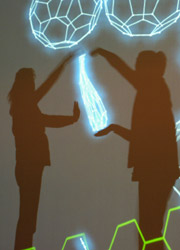|
|
|
|
Also see: Today's Top Stories
|
|
4e2 595 |
Can Art Make Nanotechnology Easier to Understand?
The old adage "seeing is believing" hardly applies to nanoscience, which
operates on a scale of atoms and molecules. So how do you make something
so miniscule and abstract appear real to the ordinary eye?
Why not through art?
Read the full story >>
|

Visitors' shadows manipulating and reshaping projected images of "buckyballs" in the exhibition "nano," currently on view in the Boone Children's Gallery at the Los Angeles County Museum of Art. |
|||||
|
8fb 15c1 |
A new exhibition at the Los Angeles County Museum of Art, called "nano," merges the art and the atom. Through art-making exhibits, visitors can experience what it's like to move molecules and manipulate atoms one by one. The project, which was created by a team of nanoscience, media arts, and humanities experts from the University of California, Los Angeles (UCLA), allows visitors to experience nanotechnology by sensing it, even when they can't see it. "This new science is about a shift in our perception of reality from a purely visual culture to one based on sensing and connectivity," said Victoria Vesna, chair of the UCLA Department of Design/Media Arts, who spearheaded the project with James Gimzewski, a UCLA chemistry professor and nanoscience pioneer. From Viewing to Sensing The word nano is Greek for "dwarf." A nanometer is one billionth of a meter. To better understand the miniscule scale of this science, consider this: The average thickness of a human hair is 50,000 nanometers. The conceptual underpinnings of the science were introduced in 1959 by the Nobel Prize-winning physicist Richard Feynman in a lecture titled "There is Plenty of Room at the Bottom." But it wasn't until the early 1970s that Japanese engineer Norio Taniguchi first proposed the term nanotechnology. Although scientists knew that matter existed on the nano scale, they were unable to analyze it through microscopes. When magnified ten thousand times in a lens-based microscope, an image starts to go fuzzy; at 100,000 times, it's blank. The breakthrough came in 1981, when scientists at the IBM laboratories in Zürich, Switzerland, invented the Scanning Tunneling Microscope, which for the first time looked at the topography of atoms that cannot be seen. The technology marked a paradigm shift in how scientists analyze miniscule matter, allowing them to record shape by tactile sensing instead of viewing it, much like a blind man reading Braille, only on the atomic scale. But most people's understanding of nanotechnology remains limited. Recently, some artists have suggested that a perceptual shift has to take place in our minds if we want to comprehend the work of nanoscience. Buckyballs The new exhibition, which is presented at the museum's Children's Gallery, is the first time nanoscientists and media artists have joined together to explore the cultural ramifications of the new technology. "We're jacking into the labs not to explain the science, but to engage it," said Vesna. At one exhibit, visitors observe a live view of the inner cell that's projected onto the surface of a table. They can move, manipulate, and reorient individual atoms in a way that is similar to operating the Scanning Tunneling Microscope. The center of the exhibition replicates a large inner cell. Inside it, visitors use their shadows to manipulate and re-shape projected images of a particular form of the carbon molecule, known as a "buckyball." Even the slightest movement affects the buckyballs, replicating atomic behavior. Perhaps the most intriguing installation incorporates a sand mandala (a cosmic diagram and ritualistic symbol of the universe that is used in both Buddhism and Hinduism) from the museum's exhibition on Nepalese and Tibetan Buddhist art. The method that Buddhist monks use to create sand images, particle by particle, resembles the arrangement of individual molecules in nanoscience. Images of a grain of sand are projected in evolving scale from the molecular structure of a single grain to the recognizable image of a pile of sand. In this bottom-up method of visual image building, the mandala slowly emerges. Mind-boggling Potential In the Quantum Tunnel, the images of visitors' faces are projected on two opposing walls. When visitors activate a camera, their image is captured and projected on the nearby wall. As the visitors walk through the connecting corridor to the opposite end, the two projected images are juxtaposed and become fractured into particles and waves. "I don't expect people to understand quantum physics," Gimzewski said. "But I expect them to notice what happens when they go through the exhibit. I'd like them to ask, 'What does this mean?'" Nanotechnology is still in its infancy. But its potential, experts say, is mind-boggling, ranging from a virtual presence in space to the repair of the human body with replacement parts. Over four billion dollars (U.S.) was invested globally in nanoscience in 2001. "Nanoscience will eventually revolutionize and impact upon every single aspect of our lives, including the arts," said Gimzewski. "It brings all the sciences together at the level of the atom. It is completely new in the way we fabricate and make things." The "nano" exhibition opened this month at the Los Angeles County of Museum of Art and runs until September 6, 2004.
c00
|
55a
1908
|
||||||||||||||||||||||||||||
| 73f | ||||||||||||||||||||||||||||||